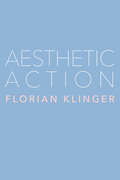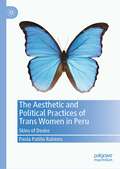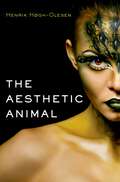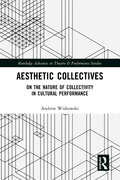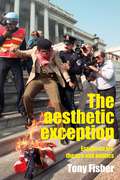- Table View
- List View
Aesthetic Action
by Florian KlingerIn this new book, Florian Klinger gives readers a basic action-theoretical account of the aesthetic. While normal action fulfills a determinate concept, Klinger argues, aesthetic action performs an indeterminacy by suspending the action's conceptual resolution. Taking as examples work by Tino Sehgal, Kara Walker, Mazen Kerbaj, Marina Abramović, Cy Twombly, and Franz Kafka, the book examines indeterminacy in such instances as a walk that is at once leisurely and purposeful, a sound piece that is at once joyous and mournful and mechanical, or a sculpture that at once draws one in and shuts one out. Because it has irresolution as its point, aesthetic action presents itself as an unsettling of ourselves, our ways, our very sense of who we are. As performers of such action, we don't recognize one another as bearers of a shared human form as we normally would, but find ourselves tasked anew with figuring out what sharing a form would mean. In conversation with philosophers such as Kant, Hegel, Wittgenstein, and Anscombe; political thinkers such as Marx and Lorde; and contemporary interlocutors such as Michael Thompson, Sebastian Rödl, and Thomas Khurana, Klinger's book makes a case for a conception of the human form that systematically includes the aesthetic: an actualization of the form that is indeterminate and nevertheless rational. The book gives the project of Western philosophical aesthetics a long-overdue formulation for our present that aims to do justice to contemporary aesthetic production as it actually exists. It will appeal to those working in philosophy, art, and political thought.
Aesthetic Action
by Florian KlingerIn this new book, Florian Klinger gives readers a basic action-theoretical account of the aesthetic. While normal action fulfills a determinate concept, Klinger argues, aesthetic action performs an indeterminacy by suspending the action's conceptual resolution. Taking as examples work by Tino Sehgal, Kara Walker, Mazen Kerbaj, Marina Abramović, Cy Twombly, and Franz Kafka, the book examines indeterminacy in such instances as a walk that is at once leisurely and purposeful, a sound piece that is at once joyous and mournful and mechanical, or a sculpture that at once draws one in and shuts one out. Because it has irresolution as its point, aesthetic action presents itself as an unsettling of ourselves, our ways, our very sense of who we are. As performers of such action, we don't recognize one another as bearers of a shared human form as we normally would, but find ourselves tasked anew with figuring out what sharing a form would mean. In conversation with philosophers such as Kant, Hegel, Wittgenstein, and Anscombe; political thinkers such as Marx and Lorde; and contemporary interlocutors such as Michael Thompson, Sebastian Rödl, and Thomas Khurana, Klinger's book makes a case for a conception of the human form that systematically includes the aesthetic: an actualization of the form that is indeterminate and nevertheless rational. The book gives the project of Western philosophical aesthetics a long-overdue formulation for our present that aims to do justice to contemporary aesthetic production as it actually exists. It will appeal to those working in philosophy, art, and political thought.
Aesthetic Afterlives: Irony, Literary Modernity and the Ends of Beauty (Continuum Literary Studies)
by Andrew EasthamSince the development of British Aestheticism in the 1870s, the concept of irony has focused a series of anxieties which are integral to modern literary practice. Examining some of the most important debates in post-Romantic aesthetics through highly focused textual readings of authors from Walter Pater and Henry James to Samuel Beckett and Alan Hollinghurst, this study investigates the dialectical position of irony in Aestheticism and its twentieth-century afterlives. Aesthetic Afterlives constructs a far-reaching theoretical narrative by positioning Victorian Aestheticism as the basis of Literary Modernity. Aestheticism's cultivation of irony and reflexive detachment was central to this legacy, but it was also the focus of its own self-critique. Anxieties about the concept and practice of irony persisted through Modernism, and have recently been positioned in Hollinghurst's work as a symptom of the political stasis within post-modern culture. Referring to the recent debates about the 'new aestheticism' and the politics of aesthetics, Eastham asks how a utopian Aestheticism can be reconstructed from the problematics of irony and aesthetic autonomy that haunted writers from Pater to Adorno.
Aesthetic Afterlives: Irony, Literary Modernity and the Ends of Beauty (Continuum Literary Studies)
by Andrew EasthamSince the development of British Aestheticism in the 1870s, the concept of irony has focused a series of anxieties which are integral to modern literary practice. Examining some of the most important debates in post-Romantic aesthetics through highly focused textual readings of authors from Walter Pater and Henry James to Samuel Beckett and Alan Hollinghurst, this study investigates the dialectical position of irony in Aestheticism and its twentieth-century afterlives. Aesthetic Afterlives constructs a far-reaching theoretical narrative by positioning Victorian Aestheticism as the basis of Literary Modernity. Aestheticism's cultivation of irony and reflexive detachment was central to this legacy, but it was also the focus of its own self-critique. Anxieties about the concept and practice of irony persisted through Modernism, and have recently been positioned in Hollinghurst's work as a symptom of the political stasis within post-modern culture. Referring to the recent debates about the 'new aestheticism' and the politics of aesthetics, Eastham asks how a utopian Aestheticism can be reconstructed from the problematics of irony and aesthetic autonomy that haunted writers from Pater to Adorno.
Aesthetic and Artistic Autonomy (Bloomsbury Studies in Philosophy)
by Owen HulattWhether art can be wholly autonomous has been repeatedly challenged in the modern history of aesthetics. In this collection of specially-commissioned chapters, a team of experts discuss the extent to which art can be explained purely in terms of aesthetic categories. Covering examples from Philosophy, Music and Art History and drawing on continental and analytic sources, this volume clarifies the relationship between artworks and extra-aesthetic considerations, including historic, cultural or economic factors. It presents a comprehensive overview of the questionof aesthetic autonomy, exploring its relevance to both philosophy and the comprehension of specific artworks themselves. By closely examining how the creation of artworks, and our judgements of these artworks, relate to society and history, Aesthetic and Artistic Autonomy provides an insightful and sustained discussion of a major question in aesthetic philosophy.
Aesthetic and Artistic Autonomy (Bloomsbury Studies in Philosophy)
by Owen HulattWhether art can be wholly autonomous has been repeatedly challenged in the modern history of aesthetics. In this collection of specially-commissioned chapters, a team of experts discuss the extent to which art can be explained purely in terms of aesthetic categories. Covering examples from Philosophy, Music and Art History and drawing on continental and analytic sources, this volume clarifies the relationship between artworks and extra-aesthetic considerations, including historic, cultural or economic factors. It presents a comprehensive overview of the questionof aesthetic autonomy, exploring its relevance to both philosophy and the comprehension of specific artworks themselves. By closely examining how the creation of artworks, and our judgements of these artworks, relate to society and history, Aesthetic and Artistic Autonomy provides an insightful and sustained discussion of a major question in aesthetic philosophy.
The Aesthetic and Political Practices of Trans Women in Peru: Skins of Desire
by Paola Patiño RabinesThis book explores the political-aesthetic practices of transgender women in Lima, Peru, and how they use these to survive and fight for recognition and full citizenship, through drawing on ethnographic research and on decolonial feminist and aesthetic theories. Chapters analyze how the vulnerability and precariousness of trans women coexist with modes of feminist agency, resistance and resilience, as well as with proposals for political action to transform a heteropatriarchal society toward a more diverse and accepting one. Finally, the author draws on the Viennese artist Friedensreich Hundertwasser’s metaphor of the five skins, whereby the first skin is the epidermis; the second is the clothes; the third is the house; the fourth is identity, which refers to primary socialization spaces such as the neighbourhood; and the fifth is the world environment. The author uses this metaphor to analyze the corporal practices of trans women in a cumulative way, paying special attention to the different stages of their lives, to those skins that embody and accompany them from childhood to adulthood.This book will be of interest to scholars of transgender studies, decolonial feminist studies, and aesthetic, particularly those with a focus on gender and sexuality in Latin America.
The Aesthetic Animal
by Henrik Hogh-OlesenThe Aesthetic Animal answers the ultimate questions of why we adorn ourselves, embellish our things and surroundings, and produce art, music, song dance, and fiction. Humans are aesthetic animals that spend vast amounts of time and resources on seemingly useless aesthetic activities. However, nature would not allow a species to waste precious time and effort on activities completely unrelated to survival, reproduction, and the well-being of that species. Consequently, the aesthetic impulse must have some important biological functions. A number of observations indicate that the aesthetic impulse is an inherent part of human nature, and therefore a primary impulse in its own right with several important functions: The aesthetic impulse may guide us toward what is biologically good for us, and help us choose the right fitness enhancing items in our surroundings. It is a valid individual fitness indicator as well as a unifying social group marker, and aesthetically skilled individuals get more mating possibilities, higher status and more collaborative offers. The book is written in a lively and entertaining tone, with beautiful color illustrations. It covers a wide field of aesthetic behaviors from cave art, graffiti, tattoos, and piercings over fashion, design, music, song, and dance. It presents an original and comprehensive synthesis of the empirical field, synthesizing data from archeology, cave art, anthropology, biology, ethology, behavioral- and evolutionary psychology and neuro-aesthetics. It is a must-read for people interested in biology, psychology, anthropology, architecture, design, fashion, body culture, art, and the evolution of aesthetics.
The Aesthetic Animal
by Henrik Hogh-OlesenThe Aesthetic Animal answers the ultimate questions of why we adorn ourselves, embellish our things and surroundings, and produce art, music, song dance, and fiction. Humans are aesthetic animals that spend vast amounts of time and resources on seemingly useless aesthetic activities. However, nature would not allow a species to waste precious time and effort on activities completely unrelated to survival, reproduction, and the well-being of that species. Consequently, the aesthetic impulse must have some important biological functions. A number of observations indicate that the aesthetic impulse is an inherent part of human nature, and therefore a primary impulse in its own right with several important functions: The aesthetic impulse may guide us toward what is biologically good for us, and help us choose the right fitness enhancing items in our surroundings. It is a valid individual fitness indicator as well as a unifying social group marker, and aesthetically skilled individuals get more mating possibilities, higher status and more collaborative offers. The book is written in a lively and entertaining tone, with beautiful color illustrations. It covers a wide field of aesthetic behaviors from cave art, graffiti, tattoos, and piercings over fashion, design, music, song, and dance. It presents an original and comprehensive synthesis of the empirical field, synthesizing data from archeology, cave art, anthropology, biology, ethology, behavioral- and evolutionary psychology and neuro-aesthetics. It is a must-read for people interested in biology, psychology, anthropology, architecture, design, fashion, body culture, art, and the evolution of aesthetics.
The Aesthetic Cold War: Decolonization and Global Literature
by Peter J. KallineyHow decolonization and the cold war influenced literature from Africa, Asia, and the CaribbeanHow did superpower competition and the cold war affect writers in the decolonizing world? In The Aesthetic Cold War, Peter Kalliney explores the various ways that rival states used cultural diplomacy and the political police to influence writers. In response, many writers from Africa, Asia, and the Caribbean—such as Chinua Achebe, Mulk Raj Anand, Eileen Chang, C.L.R. James, Alex La Guma, Doris Lessing, Ngũgĩ wa Thiong'o, and Wole Soyinka—carved out a vibrant conceptual space of aesthetic nonalignment, imagining a different and freer future for their work.Kalliney looks at how the United States and the Soviet Union, in an effort to court writers, funded international conferences, arts centers, book and magazine publishing, literary prizes, and radio programming. International spy networks, however, subjected these same writers to surveillance and intimidation by tracking their movements, tapping their phones, reading their mail, and censoring or banning their work. Writers from the global south also suffered travel restrictions, deportations, imprisonment, and even death at the hands of government agents. Although conventional wisdom suggests that cold war pressures stunted the development of postcolonial literature, Kalliney's extensive archival research shows that evenly balanced superpower competition allowed savvy writers to accept patronage without pledging loyalty to specific political blocs. Likewise, writers exploited rivalries and the emerging discourse of human rights to contest the attentions of the political police.A revisionist account of superpower involvement in literature, The Aesthetic Cold War considers how politics shaped literary production in the twentieth century.
Aesthetic Collectives: On the Nature of Collectivity in Cultural Performance (Routledge Advances in Theatre & Performance Studies)
by Andrew WiskowskiThis book focuses attention on groups of performing people that are unique aesthetic objects, the focus of an artist’s vision, but at the same time a collective being; a singular, whole mass that exists and behaves like an individual entity. This text explores this unique experience, which is far from rare or special. Indeed, it is pervasive, ubiquitous and has, since the dawn of performance, been with us. Surveying installation art from Vanessa Beecroft & Kanye West, Greek tragedy, back-up dancing groups and even the mass dance of clubbing crowds, this text examines and names this phenomenon: Aesthetic Collectives. Drawing on a range of methods of investigation spanning performance studies, acting theory, studies of atmosphere and affect and sociology it presents an intervention in the literature for something that has long deserved its own attention. This book will be of great interest to scholars, students and practitioners in performance studies, theatre, live art, sociology (particularly of groups and subcultures), cultural studies and cultural geography.
Aesthetic Collectives: On the Nature of Collectivity in Cultural Performance (Routledge Advances in Theatre & Performance Studies)
by Andrew WiskowskiThis book focuses attention on groups of performing people that are unique aesthetic objects, the focus of an artist’s vision, but at the same time a collective being; a singular, whole mass that exists and behaves like an individual entity. This text explores this unique experience, which is far from rare or special. Indeed, it is pervasive, ubiquitous and has, since the dawn of performance, been with us. Surveying installation art from Vanessa Beecroft & Kanye West, Greek tragedy, back-up dancing groups and even the mass dance of clubbing crowds, this text examines and names this phenomenon: Aesthetic Collectives. Drawing on a range of methods of investigation spanning performance studies, acting theory, studies of atmosphere and affect and sociology it presents an intervention in the literature for something that has long deserved its own attention. This book will be of great interest to scholars, students and practitioners in performance studies, theatre, live art, sociology (particularly of groups and subcultures), cultural studies and cultural geography.
Aesthetic Dimension: Toward A Critique Of Marxist Aesthetics (Communications and Culture)
by Herbert MarcuseAesthetic Dimensions of Modern Philosophy
by Andrew BowieMuch of contemporary philosophy, especially in the analytical tradition, regards aesthetics as of lesser significance than epistemology, ethics, metaphysics, and the philosophy of language. Yet, in Aesthetic Dimensions of Modern Philosophy, Andrew Bowie explores the idea that art and aesthetics have crucial implications for those areas of philosophy. In the modern period, the growth of warranted scientific knowledge is accompanied both by heightened concern with epistemological scepticism and a new philosophical attention to art and the beauty of nature. This suggests that modernity involves problems concerning how human beings make sense of the world that go beyond questions of knowledge, and are reflected in the arts. The relationship of art to philosophy is explored in Montaigne, Descartes, Hume, Kant, Schelling, the early German Romantics, and Hegel. This book also considers Cassirer's and the hermeneutic tradition's exploration of close links between meaning in language and in art. The work of Karl Polanyi, Marx, Nietzsche, Heidegger, Adorno, Dewey, and others is used to investigate how the modern sciences and the development of capitalism change both humankind's relations to nature and the nature of value, and so affect the role of art in human self-understanding. The aesthetic dimensions of modern philosophy can help to uncover often neglected historical shifts in how 'subjective' and 'objective' are conceived. Seeing art as a kind of philosophy, and philosophy as a kind of art, reveals unresolved tensions between the different cultural domains of the modern world and questions some of the orientation of contemporary philosophy.
Aesthetic Dimensions of Modern Philosophy
by Andrew BowieMuch of contemporary philosophy, especially in the analytical tradition, regards aesthetics as of lesser significance than epistemology, ethics, metaphysics, and the philosophy of language. Yet, in Aesthetic Dimensions of Modern Philosophy, Andrew Bowie explores the idea that art and aesthetics have crucial implications for those areas of philosophy. In the modern period, the growth of warranted scientific knowledge is accompanied both by heightened concern with epistemological scepticism and a new philosophical attention to art and the beauty of nature. This suggests that modernity involves problems concerning how human beings make sense of the world that go beyond questions of knowledge, and are reflected in the arts. The relationship of art to philosophy is explored in Montaigne, Descartes, Hume, Kant, Schelling, the early German Romantics, and Hegel. This book also considers Cassirer's and the hermeneutic tradition's exploration of close links between meaning in language and in art. The work of Karl Polanyi, Marx, Nietzsche, Heidegger, Adorno, Dewey, and others is used to investigate how the modern sciences and the development of capitalism change both humankind's relations to nature and the nature of value, and so affect the role of art in human self-understanding. The aesthetic dimensions of modern philosophy can help to uncover often neglected historical shifts in how 'subjective' and 'objective' are conceived. Seeing art as a kind of philosophy, and philosophy as a kind of art, reveals unresolved tensions between the different cultural domains of the modern world and questions some of the orientation of contemporary philosophy.
The Aesthetic Discourse of the Arts: Breaking the Barriers (Analecta Husserliana #61)
by Anna-Teresa TymienieckaThe fine arts first emerged divided by the five senses yet, since their very origin, they have projected aesthetic networks among themselves. Music, song, painting, architecture, sculpture, theatre, dance - distinct in themselves - grew together, enhancing each other. In the present outburst of technical ingeniosity, individual arts cross all barriers, as well as proliferate in kind. Hence the traditional criteria of appreciation and enjoyment vanish. The enlarged and ever-growing field calls for new principles of appreciation and new values, essential to our culture. This collection initiates an inquiry into the aesthetic foundations of the fine arts. Their common aesthetic nature, as well as the differentiating specificities which sustain them, might reveal the universal role of aesthetics in human life. Studies by Paula Carabell, J. Fiori Blanchfield, R. Riese Hubert, R. Gray, D. Lipten, J. Parsons, S. Brown, C. Osowie Ruoff, T. Raczka, K. Karbenier and others.
Aesthetic Disinterestedness: Art, Experience, and the Self (Routledge Studies in Contemporary Philosophy)
by Thomas HilgersThe notion of disinterestedness is often conceived of as antiquated or ideological. In spite of this, Hilgers argues that one cannot reject it if one wishes to understand the nature of art. He claims that an artwork typically asks a person to adopt a disinterested attitude towards what it shows, and that the effect of such an adoption is that it makes the person temporarily lose the sense of herself, while enabling her to gain a sense of the other. Due to an artwork’s particular wealth, multiperspectivity, and dialecticity, the engagement with it cannot culminate in the construction of world-views, but must initiate a process of self-critical thinking, which is a precondition of real self-determination. Ultimately, then, the aesthetic experience of art consists of a dynamic process of losing the sense of oneself, while gaining a sense of the other, and of achieving selfhood. In his book, Hilgers spells out the nature of this process by means of rethinking Kant’s and Schopenhauer’s aesthetic theories in light of more recent developments in philosophy–specifically in hermeneutics, critical theory, and analytic philosophy–and within the arts themselves–specifically within film and performance art.
Aesthetic Disinterestedness: Art, Experience, and the Self (Routledge Studies in Contemporary Philosophy)
by Thomas HilgersThe notion of disinterestedness is often conceived of as antiquated or ideological. In spite of this, Hilgers argues that one cannot reject it if one wishes to understand the nature of art. He claims that an artwork typically asks a person to adopt a disinterested attitude towards what it shows, and that the effect of such an adoption is that it makes the person temporarily lose the sense of herself, while enabling her to gain a sense of the other. Due to an artwork’s particular wealth, multiperspectivity, and dialecticity, the engagement with it cannot culminate in the construction of world-views, but must initiate a process of self-critical thinking, which is a precondition of real self-determination. Ultimately, then, the aesthetic experience of art consists of a dynamic process of losing the sense of oneself, while gaining a sense of the other, and of achieving selfhood. In his book, Hilgers spells out the nature of this process by means of rethinking Kant’s and Schopenhauer’s aesthetic theories in light of more recent developments in philosophy–specifically in hermeneutics, critical theory, and analytic philosophy–and within the arts themselves–specifically within film and performance art.
The aesthetic exception: Essays on art, theatre, and politics
by Tony FisherThe aesthetic exception theorises anew the relation between art and politics. It challenges critical trends that discount the role of aesthetic autonomy, to impulsively reassert art as an effective form of social engagement. But it equally challenges those on the flipside of the efficacy debate, who insist that art’s politics is limited to a recondite space of ‘autonomous resistance’. The book shows how each side of the efficacy debate overlooks art’s exceptional status and its social mediations. Mobilising philosophy and cultural theory, and employing examples from visual art, performance, and theatre, it proposes four alternative tests to ‘effect’ to offer a nuanced account of art’s political character. Those tests examine how art relates to politics as a practice that articulates its historical conjuncture, and how it prefigures the ‘new’ through simulations capable of activating the political life of the spectator.
The aesthetic exception: Essays on art, theatre, and politics
by Tony FisherThe aesthetic exception theorises anew the relation between art and politics. It challenges critical trends that discount the role of aesthetic autonomy, to impulsively reassert art as an effective form of social engagement. But it equally challenges those on the flipside of the efficacy debate, who insist that art’s politics is limited to a recondite space of ‘autonomous resistance’. The book shows how each side of the efficacy debate overlooks art’s exceptional status and its social mediations. Mobilising philosophy and cultural theory, and employing examples from visual art, performance, and theatre, it proposes four alternative tests to ‘effect’ to offer a nuanced account of art’s political character. Those tests examine how art relates to politics as a practice that articulates its historical conjuncture, and how it prefigures the ‘new’ through simulations capable of activating the political life of the spectator.
Aesthetic Experience and Moral Vision in Plato, Kant, and Murdoch: Looking Good/Being Good
by Meredith Trexler DreesThis book addresses how Plato, Kant, and Iris Murdoch (each in different ways) view the connection aesthetic experience has to morality. While offering an examination of Iris Murdoch’s philosophy, it analyses deeply the suggestive links (as well as essential distinctions) between Plato’s and Kant’s philosophies. Meredith Trexler Drees considers not only Iris Murdoch’s concept of unselfing, but also its relationship with Kant’s view of Achtung and Plato’s view of Eros. In addition, Trexler Drees suggests an extended, and partially amended, version of Murdoch’s view, arguing that it is more compatible with a religious way of life than Murdoch herself realized. This leads to an expansion of the overall argument to include Kant’s affirmation of religion as an area of life that can be improved through Plato’s and Murdoch’s vision of how being good and being beautiful can be part of the same life-task.
The Aesthetic Experience of Dying: The Dance to Death
by Veronica M. AdamsonStructured around a personal account of the illness and death of the author’s partner, Jane, this book explores how something hard to bear became a threshold to a world of insight and discovery. Drawing on German Idealism and Jane’s own research in the area, The Aesthetic Experience of Dying looks at the notion of life as a binary synthesis, or a return enhanced, as a way of coming to understand death. Binary synthesis describes the interplay between dynamically opposing pairs of concepts – such as life and death – resulting in an enhanced version of one of them to move forward in a new cycle of the process. Yet what relevance does this elegant word game have to the shocking diagnosis of serious illness? Struggling to balance reason with sense, thought with feeling, this book examines the experience of caring for someone from diagnosis to death and is illustrated with examples of the return enhanced. The concluding chapter outlines how the tension of Jane’s dying has been resolved as the rhythmic patterns of the lifeworld have been understood through the process of reflecting on the experience. This creative and insightful book will appeal to those interested in the medical humanities. It will also be an important reference for practising and student health professionals.
The Aesthetic Experience of Dying: The Dance to Death
by Veronica M. AdamsonStructured around a personal account of the illness and death of the author’s partner, Jane, this book explores how something hard to bear became a threshold to a world of insight and discovery. Drawing on German Idealism and Jane’s own research in the area, The Aesthetic Experience of Dying looks at the notion of life as a binary synthesis, or a return enhanced, as a way of coming to understand death. Binary synthesis describes the interplay between dynamically opposing pairs of concepts – such as life and death – resulting in an enhanced version of one of them to move forward in a new cycle of the process. Yet what relevance does this elegant word game have to the shocking diagnosis of serious illness? Struggling to balance reason with sense, thought with feeling, this book examines the experience of caring for someone from diagnosis to death and is illustrated with examples of the return enhanced. The concluding chapter outlines how the tension of Jane’s dying has been resolved as the rhythmic patterns of the lifeworld have been understood through the process of reflecting on the experience. This creative and insightful book will appeal to those interested in the medical humanities. It will also be an important reference for practising and student health professionals.
The Aesthetic Illusion in Literature and the Arts
by Jiri Koten Emily Troscianko Thomas Pavel Martin Pokorny Fredrik Stjernberg Werner Wolf Karel Thein Enrico Terrone Marco Caracciolo Petr Kotatko Tomáš KoblížekThe notion of aesthetic illusion relates to a number of art forms and media. Defined as a pleasurable mental state that emerges during the reception of texts and artefacts, it amounts to the reader's or viewer's sense of having entered the represented world while at the same time keeping a distance from it. Aesthetic Illusion in Literature and the Arts is an in-depth study of the main questions surrounding this experience of art as reality.Beginning with an introduction providing historical background to modern discussions of illusion, it deals with a wide range of theoretical issues. The collection explores the nature and function of the aesthetic illusion as well as the role of affect and emotion, the implications of aesthetic illusion for the theory of fiction, the variable forms of aesthetic illusion and its relationship to other components of aesthetic response. Aesthetic Illusion in Literature and the Arts brings together a team of scholars from philosophy, literature and art and presents an interdisciplinary examination of a concept lying at the heart of contemporary aesthetics.
The Aesthetic Illusion in Literature and the Arts
by Jiri Koten Emily Troscianko Thomas Pavel Martin Pokorny Fredrik Stjernberg Werner Wolf Karel Thein Enrico Terrone Marco Caracciolo Petr Kotatko Tomáš KoblížekThe notion of aesthetic illusion relates to a number of art forms and media. Defined as a pleasurable mental state that emerges during the reception of texts and artefacts, it amounts to the reader's or viewer's sense of having entered the represented world while at the same time keeping a distance from it. Aesthetic Illusion in Literature and the Arts is an in-depth study of the main questions surrounding this experience of art as reality.Beginning with an introduction providing historical background to modern discussions of illusion, it deals with a wide range of theoretical issues. The collection explores the nature and function of the aesthetic illusion as well as the role of affect and emotion, the implications of aesthetic illusion for the theory of fiction, the variable forms of aesthetic illusion and its relationship to other components of aesthetic response. Aesthetic Illusion in Literature and the Arts brings together a team of scholars from philosophy, literature and art and presents an interdisciplinary examination of a concept lying at the heart of contemporary aesthetics.
